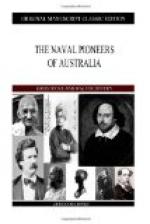Phillip’s commission made him governor-in-chief, and captain-general over all New South Wales, which then meant from Cape York, in the extreme north of Australia, to the “south cape of Van Diemen’s Land,” then, of course, supposed to be part of the main continent. He was ordered to land at Botany Bay and there form the settlement, but was given a discretionary power to change the site, if he considered it unsuitable.
[Illustration: A VIEW OF BOTANY BAY. From an engraving from a drawing by R. Cleveley, in “The Voyage of Governor Phillip to Botany Bay” [London, 1789].]
Recognizing the unsuitability of Botany Bay, Phillip, before all the ships of the first fleet were arrived, set out in an [Sidenote: 1788] open boat to explore the coast; and so, sailing northward, entered that bay only mentioned by Cook in the words before quoted, “abrest of an open bay,” and by Hawkesworth (writing in the first person as Cook) thus:—
“At this time” (noon May 6th, 1770) “we were between two and three miles from the land and abrest of a good bay or harbour, in which there appeared to be a good anchorage, and which I called Port Jackson.”
Perhaps, when Phillip’s boat passed between the north and south heads of Port Jackson, he exclaimed what has so often been repeated since: “What a magnificent harbour!” And so on the 26th January, 1788, Sydney was founded upon the shores of the most beautiful bay in the world.
Phillip’s “eye for ground” told him that the shores of Port Jackson were a better site for a settlement than the land near Botany Bay, but he had no sooner landed his people than the need for better soil than Sydney afforded was apparent. Then began a series of land expeditions into the interior, in which, with such poor means as these pioneers possessed, the country was penetrated right to the foot of the Blue Mountains. The first governor, despite the slight foothold he had established at Sydney—little better such a home than the deck of a ship—persistently searched for good land, and before his five years of office had expired agricultural settlement was fairly under way.




